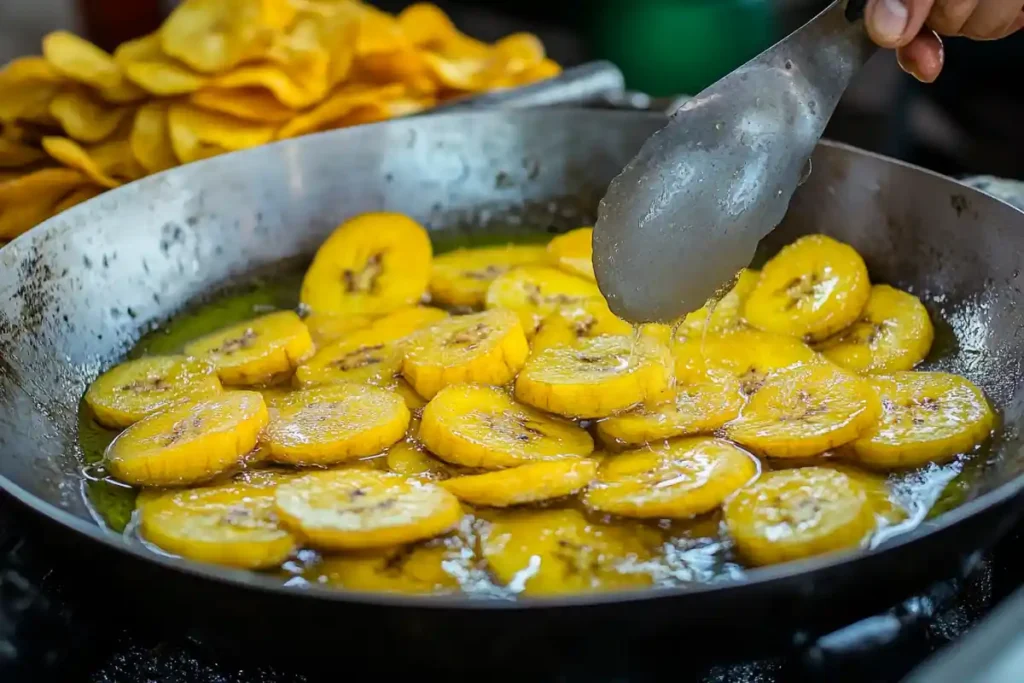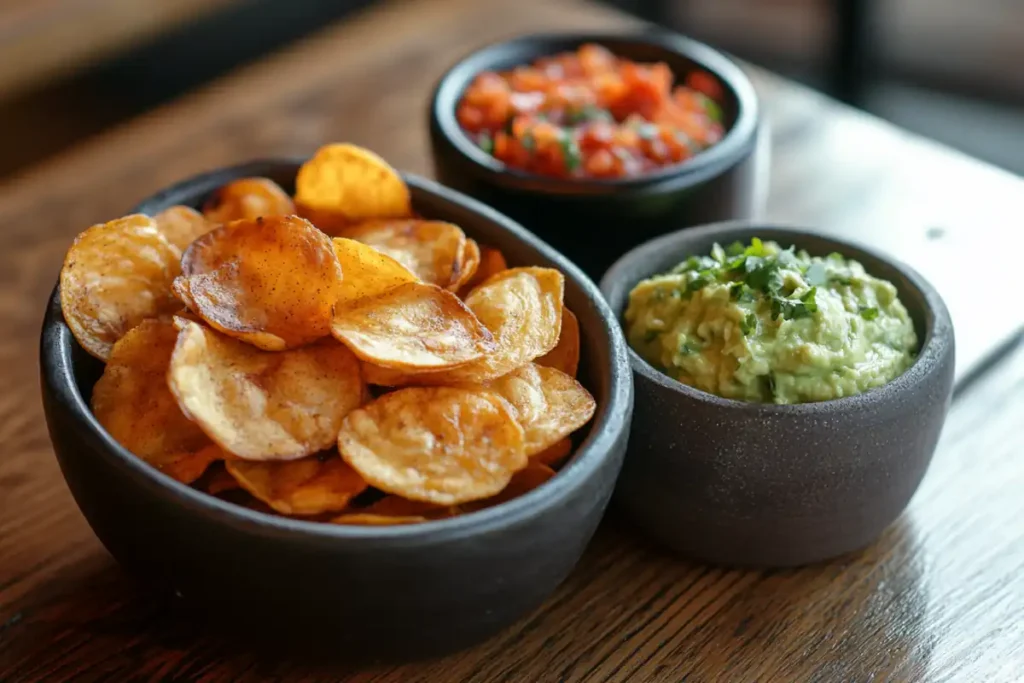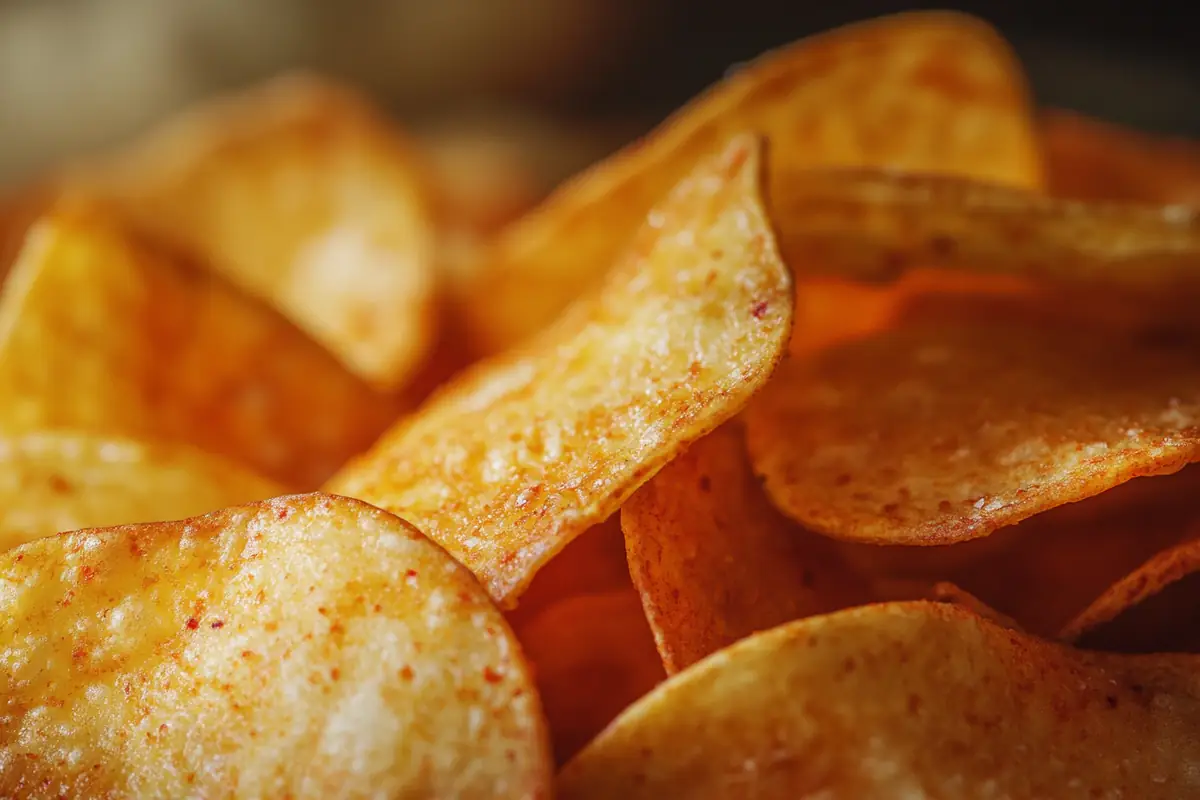Introduction
What are plantain chips made of? Many people enjoy them, yet few understand their origins. Accordingly, these crispy snacks offer layers of flavor and culinary history. Indeed, plantain chips originated in tropical regions, where plantains grow in abundance and form a core part of local diets. Because they have spread worldwide, you can now find them in supermarkets across the United States. Consequently, consumers enjoy plantain chips as a crunchy, salty, and sometimes sweet alternative to traditional potato chips. Meanwhile, they adapt well to different seasonings, creating a versatile snack that suits many palates. Eventually, understanding their composition can help you make more informed choices. Thus, let’s explore exactly what are plantain chips made of, the ingredients behind their distinct taste, and why they have become a popular snack.
Understanding Plantains

Before we dive into what are plantain chips made of, we must first clarify what plantains are. Basically, a plantain is not exactly a banana, although they belong to the same family. Indeed, plantains are generally larger, firmer, and starchier than their sweeter cousins. Unlike bananas, which you eat raw and ripe, plantains usually require cooking. Comparatively, plantains have a mild flavor that shifts depending on ripeness. When they are green, their taste is more neutral and starchy. Eventually, as they ripen, they become sweeter, softer, and more suitable for dessert dishes.
Because they thrive in tropical climates, plantains are grown widely in regions like Latin America, the Caribbean, Africa, and parts of Asia. Basically, wherever you find warm temperatures and consistent rainfall, you will likely discover plantains as a dietary staple. For centuries, communities in these areas have relied on plantains as a source of calories, vitamins, and minerals. Equally important, plantains are loaded with essential nutrients, including vitamin A, vitamin C, potassium, and fiber. Consequently, this makes them a valuable and versatile crop.
What are plantain chips made of? In essence, the core ingredient is the plantain itself. The type of plantain, its ripeness, and how it’s processed all influence the final texture and taste. Because plantains differ significantly from bananas, using them as a base for chips yields a different flavor profile. Their distinct starch structure helps create a crispy, robust chip that can handle various seasonings and dips.
The Basics of Plantain Chips

Plantain chips start with one primary ingredient: sliced plantains. However, the simplicity of that ingredient allows for creativity in preparation. Generally, cooks peel and thinly slice green plantains for the best chip texture. Another reason to choose green plantains is that their starchiness helps produce a crisp exterior upon frying. Essentially, when heated in oil, the starch transforms, resulting in a satisfying crunch.
After slicing, the next step involves frying the plantains. Traditionally, plantain chips fry in vegetable oil, often soybean, sunflower, or palm oil. However, some artisanal brands use coconut oil or even olive oil to create unique flavor profiles. The oil type can change the taste and nutritional content. Furthermore, some healthier approaches involve baking or air-frying rather than deep-frying. Eventually, these methods reduce the chip’s fat content.
Seasonings are minimal yet impactful. Commonly, a simple sprinkling of salt suffices. Nevertheless, you might find plantain chips flavored with chili, lime, garlic, onion, cinnamon, or other spices. Sometimes, sugar transforms plantain chips into a lightly sweet treat. Consequently, plantain chips can cater to almost any flavor preference.
Beyond the basics, store-bought varieties often contain preservatives to extend shelf life. Some may add citric acid or ascorbic acid to maintain color and freshness. Comparatively, homemade versions usually skip these additives. Indeed, all you really need are plantains, oil, and a pinch of salt. Thus, if you’re wondering what are plantain chips made of, the short answer is plantains, oil, and seasonings.
What Are Plantain Chips Made Of? A Detailed Breakdown
To answer what are plantain chips made of in more detail, let’s break down each component:
- Plantains: The main ingredient is always plantains. Generally, green plantains are preferred because they create a firmer chip texture. Until ripe, their starchy composition results in crispier chips that hold their shape well. Thus, green plantains ensure the chip emerges with a clean snap.
- Fats and Oils: Most commonly, manufacturers use neutral vegetable oils such as sunflower or canola. Meanwhile, some premium brands or home cooks opt for coconut oil, palm oil, or olive oil. Because the oil’s flavor and smoke point matter, these choices influence crispiness and taste. Indeed, oil quality can significantly affect the final product.
- Seasonings: Basic plantain chips are lightly salted. However, flavor variations abound. For example, some chips feature chili powder for heat, lime powder for tanginess, or garlic powder for savoriness. Another variant might include sweet options like a dusting of sugar and cinnamon. Consequently, you can find plantain chips that match almost any flavor preference.
- Additives and Preservatives: In packaged products, small amounts of additives might appear. This can include citric acid to preserve freshness or ascorbic acid to maintain color. Nonetheless, many brands emphasize natural, preservative-free recipes. Indeed, with a growing demand for clean labels, some companies avoid synthetic additives.
- Gluten-Free and Vegan: Plantain chips are naturally gluten-free and vegan, as they consist mainly of plant-based ingredients. Comparatively, they also fit into diets that avoid common allergens like wheat or soy. Especially in markets focused on healthy snacks, plantain chips serve as a convenient, delicious alternative.
Cultural Variations and Ingredients
Different regions have their own take on what are plantain chips made of. In Latin America, plantains are abundant, and chips are a longstanding tradition. Typically, Latin American chips may use salt, chili, and lime. In the Caribbean, plantain chips, sometimes called tostones chips, enjoy bold spice mixes, including allspice or jerk seasoning. Meanwhile, in parts of Africa, plantain chips may appear with savory spices, peanuts, or groundnuts, reflecting local culinary customs.
In the United States, where fusion cuisines thrive, plantain chips adopt a wide range of flavors. You might find barbecue-seasoned plantain chips, sour cream and onion flavors, or even ranch-seasoned versions. Eventually, global influences shape these snacks as they move from their tropical homelands to mainstream American snack aisles.
Production and Processing Methods
The journey from fresh plantain to crispy chip begins with harvesting. Farmers pick plantains at different stages of ripeness depending on the desired chip profile. Generally, green plantains are harvested, transported, and stored until ready for processing.
In commercial production, plantains are washed, peeled, and sliced using specialized machinery. Uniform thickness ensures each chip cooks evenly and crisps at the same rate. Subsequently, large industrial fryers cook the slices in hot oil until they reach the desired crispness. Afterward, they drain the chips to remove excess oil.
Next, seasonings are applied in large tumblers to ensure even coverage. The finished chips then proceed to packaging lines. Finally, they end up sealed in bags or containers with nitrogen-flushing to maintain freshness. This industrial scale ensures consistent results. Conversely, home preparation is simpler but more hands-on, using a knife and a small fryer or oven.
In addition, quality control checks occur throughout the process. Particularly, producers monitor oil temperature, chip color, moisture content, and seasoning levels. Consequently, only the best chips reach consumers.
Health Aspects
Many people ask if these chips are healthier than potato chips. Eventually, it depends on how they are prepared. Fried plantain chips contain a similar amount of fat as potato chips, especially if deep-fried. Nevertheless, plantains offer fiber, vitamins, and minerals that potatoes may lack in the same quantities. Moreover, plantain chips can provide resistant starch, which supports digestive health.
Baked plantain chips offer a healthier alternative to their fried counterparts. Without heavy oil absorption, these chips have fewer calories and less fat. Consequently, if you seek a lighter snack, baking or air-frying at home is a smart approach.
Moderation remains key. Indeed, even a healthier chip should fit into a balanced diet. Because portion control matters, enjoy a handful instead of an entire bag in one sitting. Equally, check labels for hidden sugars or excess sodium. Plantain chips themselves are gluten-free and vegan, making them suitable for many diets. Undoubtedly, they provide a better-for-you option if chosen wisely.
Choosing the Right Plantain Chips
When selecting plantain chips in a store, read the ingredient label carefully. Specifically, look for chips that list only plantains, oil, and salt. If you prefer healthier fats, choose a brand that uses coconut oil or olive oil. Another factor is sodium content. If you want to reduce salt, pick brands with low-sodium options. Furthermore, consider organic or fair-trade products if sustainability matters to you.
Additionally, avoid brands with artificial flavorings, colorings, or excessive preservatives. Indeed, the fewer the additives, the closer the chip is to its natural form. Generally, organic and small-batch brands focus on quality ingredients and ethical sourcing.
Making Your Own Plantain Chips at Home
If you truly want to control what are plantain chips made of, make them yourself. Initially, choose green plantains for a crisp texture. Peel them carefully, as green plantains have tough skins. Comparatively, slicing them thinly and uniformly ensures even cooking. Use a mandoline slicer if possible.
Next, decide on your cooking method. Frying produces the crispiest chips. Thus, heat a neutral oil like sunflower oil in a skillet or deep fryer. Fry the plantain slices in small batches until golden. Drain on paper towels and sprinkle with salt or seasonings.
However, if you prefer a lighter option, try baking. Preheat your oven to about 375°F. Arrange the slices on a parchment-lined baking sheet and brush lightly with oil. Bake until crisp, flipping once. Similarly, air-frying is a great method. Place the slices in the air fryer basket, spray with oil, and cook until crunchy. Because you control the ingredients and cooking method, homemade chips can be healthier and fresher.
For seasonings, try salt and pepper, chili and lime, garlic and herb, or even a sweet cinnamon-sugar blend. Undoubtedly, making your own plantain chips allows endless customization. Store them in airtight containers to maintain crispness. However, note that they taste best fresh, so don’t make too large a batch at once.
Pairing and Serving Suggestions
Plantain chips pair beautifully with various dips and accompaniments. For example, serve them with guacamole, hummus, or fresh salsa. Their sturdy structure makes them excellent scoops for chunky dips. Comparatively, pair them with savory spreads or a bean dip for a filling snack.
Moreover, plantain chips add texture to salads, soups, and grain bowls. Crumble them on top for extra crunch, or crush them as a breading alternative for chicken or tofu. Indeed, they can even top off a ceviche, providing a crunchy contrast to tender seafood. Another idea: pack plantain chips in school lunchboxes for a healthier snack alternative.
For beverages, pair salty plantain chips with a cold beer or a sparkling water flavored with lime. If the chips are sweetened, try a fruity iced tea or a mild coffee. Indeed, the versatility of plantain chips ensures they fit easily into any meal or snack setting.
Sustainability and Ethical Considerations
When asking what are plantain chips made of, consider the impact of sourcing plantains. Choosing brands that emphasize fair trade and sustainable farming helps support small farmers. Moreover, look for products that reduce their environmental footprint by using eco-friendly packaging and responsible manufacturing practices.
Because plantains grow in tropical climates, some producers invest in local communities and improve farming conditions. Consequently, buying ethically sourced plantain chips benefits everyone involved. By supporting responsible brands, you contribute to fair wages, reduced pesticide use, and better land management.
Plantain chips are fundamentally made from sliced green plantains, cooked in oil and seasoned with salt. While simple in their core ingredients, the preparation method (frying, baking, or air-frying) and the addition of spices create diverse flavors and textures. Cultural influences further shape the varieties of this snack. Understanding their basic composition helps consumers make informed choices, whether enjoying a homemade or store-bought version of these naturally gluten-free and vegan crisps.thumb_upthumb_down
Frequently Asked Questions (FAQ)
What are plantain chips made from?
They are mainly made from thinly sliced green plantains, fried or baked until crisp. Essentially, what are plantain chips made of? The primary ingredient is always plantains, along with oil and seasonings such as salt. Sometimes, manufacturers add minimal preservatives to maintain freshness.
Are plantains chips healthy?
Plantain chips can be healthy if prepared properly. While fried versions contain more fat, baked or air-fried plantain chips offer fewer calories. Additionally, plantains provide fiber, vitamins, and minerals. Nevertheless, moderation matters. Choose chips made with good-quality oil and minimal additives. Thus, they can be part of a balanced diet.
Are plantain chips bananas?
No, plantain chips are not the same as bananas. Although both come from related plants, these chips are made from plantains—larger, starchier relatives that are generally cooked before eating. Because of their neutral taste and hearty texture, they’re perfect for savory snacks. Bananas, in contrast, are sweeter and typically enjoyed raw.
What are plantains made of?
Plantains are made of starchy flesh, similar to a banana but firmer and less sweet. They contain fiber, potassium, vitamin A, and other nutrients. Indeed, their composition makes them versatile for various dishes. When green, their starchiness is perfect for chips, fries, or savory dishes. As they ripen, they become sweeter and suitable for desserts.

